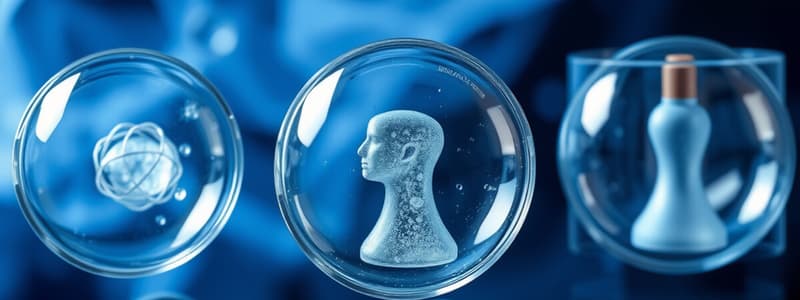Podcast
Questions and Answers
What is the primary characteristic of solids?
What is the primary characteristic of solids?
- They can flow easily.
- They have a fixed shape and volume. (correct)
- They have no fixed shape or volume.
- They consist of particles that are far apart.
Which of the following phrases best describes gas?
Which of the following phrases best describes gas?
- Has a definite volume and shape.
- Particles are close together and cannot move.
- Expands to fill the shape of the container. (correct)
- Has a fixed structure and does not flow.
Which process describes the transition from solid to gas without becoming a liquid?
Which process describes the transition from solid to gas without becoming a liquid?
- Sublimation (correct)
- Condensation
- Evaporation
- Melting
What determines whether an object will float or sink in a fluid?
What determines whether an object will float or sink in a fluid?
Which of the following is a pure substance?
Which of the following is a pure substance?
What does the Law of Conservation of Mass state?
What does the Law of Conservation of Mass state?
What physical property is used to describe the amount of space an object occupies?
What physical property is used to describe the amount of space an object occupies?
Which type of mixture has a uniform composition throughout?
Which type of mixture has a uniform composition throughout?
Flashcards are hidden until you start studying
Study Notes
Definition of Matter
- Matter is anything that has mass and occupies space.
- Exists in various states, primarily solid, liquid, gas, and plasma.
Characteristics of Matter
- Mass: Measure of the amount of substance in an object.
- Volume: Amount of space an object occupies.
- Density: Mass per unit volume; determines whether an object will float or sink in a fluid.
States of Matter
-
Solids
- Fixed shape and volume.
- Particles are tightly packed in a regular arrangement and vibrate in place.
-
Liquids
- Fixed volume but take the shape of the container.
- Particles are close together but can slide past each other.
-
Gases
- No fixed shape or volume; expand to fill the container.
- Particles are far apart and move freely.
-
Plasma
- Ionized gas with free electrons and ions.
- Found in stars, including the sun.
Changes of State
- Melting: Solid to liquid.
- Freezing: Liquid to solid.
- Vaporization: Liquid to gas (includes boiling and evaporation).
- Condensation: Gas to liquid.
- Sublimation: Solid to gas without becoming liquid (e.g., dry ice).
- Deposition: Gas to solid without becoming liquid (e.g., frost).
Properties of Matter
- Physical Properties: Characteristics observed without changing the substance (e.g., color, melting point, boiling point).
- Chemical Properties: Characteristics that determine how a substance behaves in reactions (e.g., reactivity, flammability).
Classification of Matter
- Pure Substances: Matter with a uniform and definite composition (e.g., elements and compounds).
- Mixtures: Combinations of two or more substances that retain their individual properties (e.g., homogeneous and heterogeneous mixtures).
Laws Related to Matter
- Law of Conservation of Mass: Mass is neither created nor destroyed in a chemical reaction.
- Law of Definite Proportions: A chemical compound always contains its component elements in fixed ratio by mass.
Importance of Matter
- Understanding matter is fundamental to chemistry, physics, biology, and engineering.
- Applications in everyday life include material science, pharmaceuticals, and environmental science.
Definition of Matter
- Matter comprises anything that possesses mass and occupies space.
- Exists in multiple states including solid, liquid, gas, and plasma.
Characteristics of Matter
- Mass: Quantifies the quantity of substance contained in an object.
- Volume: Measures the space an object occupies.
- Density: Defined as mass per unit of volume, influences buoyancy in fluids.
States of Matter
- Solids: Maintain a fixed shape and volume; particles are tightly packed and vibrate in position.
- Liquids: Have a fixed volume but adapt to the shape of their container; particles can slide past one another.
- Gases: Lack a fixed shape or volume; particles are widely spaced and move freely.
- Plasma: Composed of ionized gas with free-moving electrons and ions; commonly found in stars like the sun.
Changes of State
- Melting: Transition from solid to liquid.
- Freezing: Transition from liquid to solid.
- Vaporization: Transformation of liquid into gas, encompassing boiling and evaporation.
- Condensation: Conversion from gas to liquid.
- Sublimation: Direct change from solid to gas without liquid phase, as seen with dry ice.
- Deposition: Direct transition from gas to solid, such as the formation of frost.
Properties of Matter
- Physical Properties: Observable traits that do not alter the substance, including color, melting point, and boiling point.
- Chemical Properties: Traits that indicate how a substance reacts in chemical processes, such as reactivity and flammability.
Classification of Matter
- Pure Substances: Have a uniform composition and fixed properties, including elements and compounds.
- Mixtures: Combinations of two or more substances maintaining their individual characteristics, categorized as homogeneous or heterogeneous.
Laws Related to Matter
- Law of Conservation of Mass: States that mass cannot be created or destroyed during a chemical reaction.
- Law of Definite Proportions: Indicates that a chemical compound always contains its elements in a consistent mass ratio.
Importance of Matter
- Fundamental to disciplines like chemistry, physics, biology, and engineering.
- Practical implications in fields such as material science, pharmaceuticals, and environmental science.
Studying That Suits You
Use AI to generate personalized quizzes and flashcards to suit your learning preferences.




